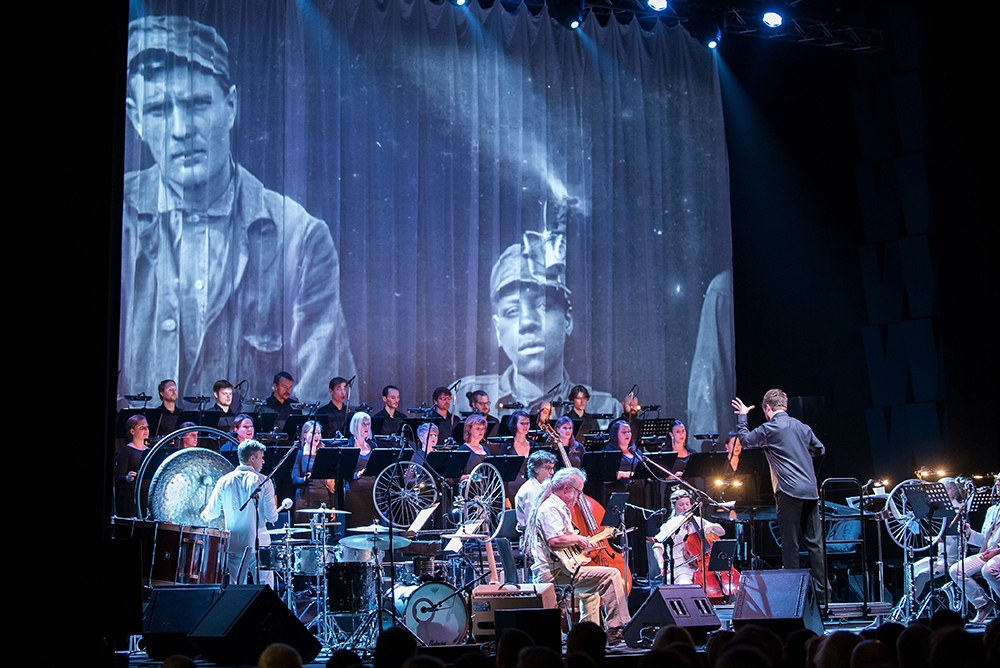FROM THE COAL MINES OF PENNSYLVANIA TO THE HORRORS OF SEPT. 11, COMPOSER JULIA WOLFE TAKES HER MUSICAL CUES FROM HISTORICAL EVENTS, INCLUDING HER LATEST WORK ABOUT THE TRIANGLE SHIRTWAIST FACTORY FIRE.
For more than a century, the hills of northeast Pennsylvania rang out with the clang of coalminers’ pickaxes, the creak of cages descending underground, and, occasionally, the rumble of explosions.
Though the mining industry largely collapsed there in the 1950s, anthracite—the hardest and hottest-burning coal—still runs through the family trees of many residents today. The hills are still piled with culm banks and laced with mineshafts, some extending well over 1,000 feet into the earth. It was deep within one of these pits that composer Julia Wolfe, ’80, found the inspiration for the haunting first movement of her 2015 Pulitzer Prize-winning oratorio, “Anthracite Fields.”

“It’s incredibly beautiful, going down into the earth,” Wolfe says. “The walls are very shiny, a little wet. In that environment, the depth affects you, the echoing.” At one point, her guide turned off the lights, plunging Wolfe into the blackest darkness. It would translate as the open strings of an upright bass and the drone of a bass clarinet—“dark textures,” she says, “that sit there and create an atmosphere.”
Wolfe’s immersive sonic atmospheres have helped to stake her reputation as one of the most important figures in contemporary classical music. Her extensive body of work, ranging from full orchestral arrangements to short pieces for a single flute or cello, takes inspiration from popular and folk genres, as well as the music—melodious or grating, beautiful or eerie—of life itself. “My Beautiful Scream,” a post-Sept. 11 concerto for orchestra and string quartet, represents what Wolfe described as her own “slow-motion scream” in reaction to the terrorist attacks near her lower Manhattan home. The unsettling “Cruel Sister” offers Wolfe’s take on an old English murder ballad, which she first heard performed by a rock band. Unusual instrumentations abound—”Lad,” from 2007, is scored for nine bagpipes, while 2012’s “riSE and fLY” calls for “body percussion.” Wolfe may be the only composer to have written parts for both sewing shears and shattering wine glasses.
“She’s simply one of the most important musicians around today,” says Matthew VanBesien, who became president of the University Musical Society in 2017 after serving the same role with the New York Philharmonic. “I’ve loved, in the last few years, to see her gain the high-profile recognition that she deserves.”
That acclaim has come for a series of works that explore and celebrate the history of American labor. “Steel Hammer,” a 2010 Pulitzer Prize finalist inspired by the folk ballad of John Henry, preceded “Anthracite Fields,” which the Los Angeles Times—in a review typical of the piece’s reception—called “a major, profound work.” In 2016, Wolfe won a MacArthur Fellowship, the award popularly known as the “genius grant.” The New York Philharmonic under VanBesien commissioned “Fire in my mouth,” her examination of the 1911 Triangle Shirtwaist Factory fire, which premiered at Lincoln Center earlier this year. At a time when the plight of the working class is of increasing political importance, Wolfe’s music is at once avant-garde, immediately relevant, and viscerally accessible.
“She’s got this wonderful humanity,” VanBesien says. “A lot of composition is very introspective, and Julia’s is, too, but it also feels like it was written for an audience. This is an artist engaging with the world.”
When Wolfe arrived at U-M’s Residential College as a freshman in the fall of 1976, her rough plan involved social sciences. But then a friend persuaded her to drop in on a course called “Creative Musicianship” the following spring. Jane Heirich, a classically trained pianist and singer who taught the class, had eclectic interests that ranged from 18th century bel canto to modern jazz and world music.
“The philosophy was, anyone is welcome, and we can work in any way that works for you,” Heirich says. Her main course requirement for the students was to create a composition each week. She enjoyed seeing what her students came up with, whether musical notation in the form of pictures or a rhythm piece that one student performed as a dance with bells attached to her ankles. The course proved especially popular with student rock bands—guitarists, drummers, and bass players would often enroll together. “Julia didn’t initially stand out, because she was in this environment where everyone stood out,” Heirich says. Aside from some piano lessons, Wolfe had no formal musical training. “But she had her mind, and her mind was ready to explore.”
Wolfe would go on to major in music and theater, studying vocal technique, composition, and even flute. After graduation, she stuck around Ann Arbor, taking in the local folk scene and experimenting with her own compositions. She wrote music for plays and took up the mountain dulcimer, an Appalachian folk instrument.
Then, on a visit out East, Wolfe met the composers Michael Gordon and David Lang. Both recent Yale School of Music graduates, they suggested she apply—which she did, graduating with a masters in music in 1986. Along the way, she and Gordon got married, and with Lang they founded Bang on a Can, an amorphous musical collective that started out in 1987 as a 12-hour music “marathon” staged in a Soho art gallery in New York City. (To Wolfe’s delight, the renowned composers John Cage and Steve Reich, among others, attended the event.)
Wolfe was now fully immersed in the music world, but she also had what she calls “the history bug,” and the historian’s approach would increasingly inform her compositions. “Anthracite Fields” draws not only from her visits to northeast Pennsylvania, but from extensive archives and interviews, political speeches, and a Pennsylvania mining accident report. A coal industry advertising campaign inspired the final movement. She wove old children’s rhymes in as well, and she discovered a list of miners involved in accidents, whose names she set as a pulsating refrain. When performed, Wolfe found her richly textured work could create surprising moments of connection.
“People came up to me after performances to tell me about their families,” Wolfe says. “One woman told me her father had died of black lung. In Los Angeles, a woman came up to me and said, ‘My grandfather is on your list.’ They felt that I’d honored their relatives, and that was very important to me.”
Honoring the dead was also a central theme in Wolfe’s latest major work, “Fire in my mouth,” which began as Wolfe’s response to VanBesien’s request for “a New York story.” She has taught at New York University since 2009, and the Greenwich Village building that formerly housed the Triangle Shirtwaist Factory, where 146 garment workers died in an inferno in 1911, is now part of its sprawling campus. “I walk by there all the time,” says Wolfe, who is now artistic director of music composition at NYU. “I had been thinking about the garment industry and about women workers.” Like the men who mined anthracite, the women who worked at the Triangle Shirtwaist Factory were immigrants; many had only recently passed through Ellis Island.
“They were self-educated—they came with almost nothing except their sewing skills,” says Wolfe, who dedicated her composition’s first movement to telling the story of their trans-Atlantic journey. The second movement reimagines a factory floor—“cellos clicking, brass blowing—it’s just this cacophony,” she says. Also in the mix are large sewing shears, snapped rhythmically open and shut by the choir; Yiddish and Italian folk songs; and snippets of newspaper accounts and speeches by garment workers who fought for their rights—an effort fueled by the tragedy, which ultimately led to workplace safeguards that saved lives.“
The fire was the hardest part to set,” Wolfe says. “It’s so tragic and so dark—you don’t want to be melodramatic, but you want it to be strong enough.”
Eventually, Wolfe adopted for her lyric the simple line “I see them falling,” as many people witnessed women jumping out of windows to escape the fire. On stage, the singers’ ranks swell to 146 as a young women’s chorus enters the hall, and—echoing the list of doomed miners in “Anthracite Fields”—Wolfe ends “Fire in my mouth” with the recitation of each victim’s name.
“It’s incredibly painful to think about what these people went through,” she says. “The idea of squashing a collective voice! I imagine these miners who protested, the women who protested their conditions, even before the fire. I just wanted to convey respect.”
Wolfe workshopped some of “Fire in my mouth” while at U-M (UMS is a co-commissioner), and she is hoping to bring it back to Ann Arbor for a full public performance. “Our wheels are turning about how we could do it here,” says VanBesien.
Meanwhile, she’s working on a new commission for the Los Angeles Philharmonic titled “Flower Power,” inspired, in Wolfe’s words, by “the idealism and psychedelia of the late 1960s.” The sound she settles on might wind up being very different from the darkness she brought out of the Pennsylvania mineshaft and the shop floors of the Triangle Shirtwaist Factory. But the theme is in keeping with the spirit of free expression Wolfe discovered in Heirich’s class and the social conscience that runs like a thread throughout her work.
“She was a student at a time when people were going to save the world,” says Heirich, who retired from the Residential College in 2004 but kept in touch with her former pupil. “I’ve watched her through all of this, and her imagination, her concern for people, for injustice—it all makes sense because she carried that spark with her when she first got dragged into my class.”
Amy Crawford is a freelance writer whose work has appeared in Smithsonian, The Boston Globe, and Nature Conservancy magazine. Follow her on @amymcrawf.





